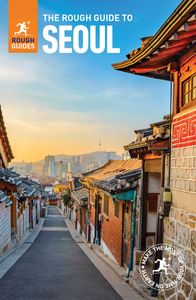Bulguksa and around
Sitting comfortably under the tree-lined wings of the surrounding mountains, Bulguksa (불국사) was built in 528 during the reign of King Beop-heung, under whose leadership Buddhism was adopted as the Silla state religion. It was almost destroyed by the Japanese invasions in 1593 and, though it’s hard to believe now, was left to rot until the 1970s, when dictatorial president Park Chung-hee ordered its reconstruction. It has subsequently been added to the UNESCO World Heritage list. As one of the most visited temples in the country, it can be thronged with people, many of whom combine their visit with a picnic on and around the path leading from the bus stop to the ticket office. Once through the gates, you’ll walk a pretty path past a pond and over a bridge, before being confronted by the temple. Here two staircases lead to the upper level; these are officially “four bridges” rather than two flights of steps, leading followers from the worldly realm to that of the Buddha. Both are listed as national treasures, so you’re not actually allowed to ascend them. Having entered the main courtyard, you’ll be confronted by yet more treasures, this time two three-level stone pagodas from the Unified Silla period; one plain and one ornately decorated, representing Yin and Yang.
From the courtyard, it’s best to stroll aimlessly and appreciate the views. The whole complex has been elaborately painted, but the artistry is particularly impressive in Daeungjeon, the main hall behind the pagodas, whose eaves are decorated both inside and out with striking patterns. At the top of the complex, another hall – Gwaneumjeon – looks down over Bulguksa’s pleasing array of roof tiles; the steep staircase down causes problems for Korean girls in high heels, but there are other ways back. Making your way across the rear of the complex you’ll come to Nahanjeon, a hall surrounded by bamboo and a cloak of maple leaves. Behind this lie small towers of stacked stones; you’re welcome – expected – to add your own. The tearoom beneath the nearby trinket shop provides a useful rest stop.
Gyeongju festivals
Throughout the year the city puts on many shows and events to please its guests. In warmer months, regular performances of traditional song and dance take place on Bomun Lake and around Anapji Pond at 8pm on Saturdays from April to October, but the biggest event by far is the three-day Silla Cultural Festival, in October, one of the best and most colourful in the land. On the menu are wrestling, archery, singing and dancing, and a parade in which a mock Silla king and queen are carried down the streets. Other events include the Cherry Blossom Marathon, held on the first Saturday of April, and a Traditional Drink and Rice-Cake Festival in late March, while on December 31 the New Year’s crowd heads to King Munmu’s seaside tomb to ring in the change of digits and enjoy the first sunrise of the year.
Namsan Park
Central Gyeongju’s ragtag assortment of buildings fades to the south, turning from urban to rural. Mercifully, development of this area is unlikely, as the city is hemmed in on its southern flank by Namsan Park, a small mountain area packed with trails and sights. New discoveries of ancient relics are made regularly, but even if you don’t find yourself unearthing a piece of Silla jewellery, this is another of the city’s must-sees. Roads run along the park’s perimeter, giving access to a wealth of sights on both sides, while the interior is strewn with carved Buddhas and offers some fantastic hikes. Namsan is best tackled either by bicycle around its pleasantly traffic-free perimeter, or with a pair of hiking boots through its interior.
Tumuli Park
Gyeongju is often described by the Korean tourist board as an open-air museum, thanks to its large number of grassy regal, burial mounds. The tombs in question are known as Tumuli, which are prolific and impossible to miss. Right in the centre of town, the walled-off Tumuli Park (대릉원) contains over two dozen tombs. It’s hard to imagine that this was until quite recently a functioning – though quiet – part of town, but in the 1970s the buildings were removed and the area beautified, creating a path- and tree-filled park that’s wonderful for a stroll. Entrances are located at the east and north of the complex, but its most famous hump sits to the far west. Here lies Cheonmachong (천마총), the only tomb in Korea that you can actually enter. Its former inhabitant is not known for sure, but is believed to be a sixth- or seventh-century king whose many horse-related implements gave rise to the name – Cheonmachong means “Heavenly Horse Tomb”. Excavated in 1973, it yielded over twelve thousand artefacts, which was the largest single haul in the country, and although many went to Gyeongju Museum, a few decorate the inner walls of the tomb. There’s also a full-scale mock-up of how the inhabitant was buried. Elsewhere in the complex is the large tomb of King Michu, who reigned from 262 to 284 and fought many battles to protect his empire from the neighbouring Baekje dynasty. According to legend, he even dispatched a ghost army from beyond the grave when his successor was losing one particular bout of fisticuffs; these phantoms disappeared during the resulting celebrations, leaving behind only the bamboo leaves that had infested the cavities of the enemy dead. For this reason, the tomb is often referred to as the “Tomb of the Bamboo Chief”. One other tomb of note is the double-humped Hwangnam Daechong, which was almost certainly the resting place of a king and queen.




















